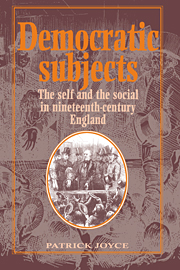Book contents
- Frontmatter
- Contents
- List of plates
- Acknowledgements
- Introduction
- Part One The sorrows of Edwin Waugh: a study in ‘working-class’ identity
- Part Two John Bright and the English people: a study in ‘middle-class’ identity
- Part Three Democratic romances: narrative as collective identity in nineteenth-century England
- 12 Narrative and history
- 13 The romance of improvement
- 14 The aesthetic framing of the social
- 15 The constitution as an English Eden
- 16 The story of the cruel Turk
- 17 Some democratic leading men, or Mr Gladstone's dream
- Appendices
- Index
16 - The story of the cruel Turk
Published online by Cambridge University Press: 10 December 2009
- Frontmatter
- Contents
- List of plates
- Acknowledgements
- Introduction
- Part One The sorrows of Edwin Waugh: a study in ‘working-class’ identity
- Part Two John Bright and the English people: a study in ‘middle-class’ identity
- Part Three Democratic romances: narrative as collective identity in nineteenth-century England
- 12 Narrative and history
- 13 The romance of improvement
- 14 The aesthetic framing of the social
- 15 The constitution as an English Eden
- 16 The story of the cruel Turk
- 17 Some democratic leading men, or Mr Gladstone's dream
- Appendices
- Index
Summary
When the Reform Act was passed in 1867 the politics of the excluded began to become the politics of the included. The countryside remained to be enfranchised, in 1884, so that the old narratives, which had taken their bearings from the experience of political exclusion, still remained important. None the less, for large parts of the electorate the problem became what to do with power once it was acquired. What happened when the stake in the country asked for in 1866 was given, when England was given back to the people? The politics of democratic representation became the politics of democratic accountability and action. What should the people do to justify themselves? What also should the political parties do to be saved? For their task now became that of allying the old, pre-1867, electorate with the new as the viable basis for the re-invention of party on the basis of a new demos. This alliance also depended on putting demos into action, on a politics of forward movement and accountability.
Here other of the theoretical aspects of narrative discussed earlier become evident. Although we can see in the politics so far described – in the relation of Bright and his audiences for instance – that unity of the tale, the teller, and the told seen to be characteristic of the successful operation of narrative, it is also necessary to bear in mind the fragility of narrative, its tendency to consume itself.
- Type
- Chapter
- Information
- Democratic SubjectsThe Self and the Social in Nineteenth-Century England, pp. 204 - 212Publisher: Cambridge University PressPrint publication year: 1994



